Eastern hornet fly
(Spilomyia longicornis)
Conservation • Description • Habitat • Ecology • Distribution • Taxonomy
Conservation Status |
|||
| IUCN Red List | not listed |
||
| NatureServe | NNR - Unranked |
||
| Minnesota | not listed |
||
Description |
Eastern hornet fly is a medium-sized, wasp-mimicking, flower fly. It occurs in the United States east of the Great Plains, and in Ontario and Quebec, Canada. Minnesota it is at the western extent of its range, and it has been recorded only in and around the Metro region of the state. Adults are found from late May to late October hovering around flowers in hardwood forests, often on hilltops. Larvae are found in deep rotholes in trees. A rothole is a cavity formed at the site of a wound as the result of fungal and bacterial action. A deep rothole is a rothole that does not heal. The water inside is mostly from the vascular system of the tree, not from rain, and is reddish-brown, not clear. Eastern hornet fly mimics vespid wasps (family Vespidae) in both appearance and behavior, but unlike wasps it cannot sting. The face is yellow and straight, not concave. The lateral parts of the head (gena), equivalent to the cheeks, are yellow. A black line separates the face and gena. The antennae are are black and short. They have three segments with a large, brownish-yellow bristle (arista) on the third segment. The second segment is elongated, much longer than wide. The structure of protruding mouthparts (proboscis) is short and fleshy. There are two large compound eyes on the sides of the head and three small simple eyes (ocelli) in a triangle on the top of the head. The compound eyes are dark brown with an obvious yellow pigmented pattern that helps to disguise the large eyes. On the male the compound eyes meet at the top of the head. On the female they do not meet, and the black lines between the face and gena taper and converge approaching the ocelli, becoming a single thin brown line at the front ocellus. The thorax is black with yellow markings. The large exoskeletal plate (scutum) covering the middle segment of the thorax has two pairs of yellow spots on the front margin, a yellow line on each side from the rear margin that bends inward at the transverse suture, and a pair of oblique yellow lines at the rear margin that form an inverted V. The small plate between the thorax and abdomen (scutellum) is black with a broad yellow margin around the sides and rear. The abdomen has four segments, and each segment is covered by a hardened exoskeletal plate (tergite). Tergite 1 is entirely black. Tergites 2, 3, and 4 are black with a yellow band about one quarter the distance between the front and rear margins (anteromedial band), a yellow band on the rear margin, and yellow lateral margins. The black area between the two bands is much broader than either band. The front band on tergite 2 is complete but may be shallowly notched in the middle. On tergite 3 the front band is deeply notched or slightly separated in the middle. On tergite 4 the front band is noticeably separated in the middle. On the male the rear band on tergite 4 is straight, not curved. The rear band on all tergites may be complete or have a thin black line in the middle. All of the yellow bands are hairless. The wings are mostly clear but the front third is darkened. The small, knob-like structures on each side of the thorax (halteres) used for balancing in flight are yellow. There is a spurious vein between the radius (R) and media (M) veins. The cross-vein that runs between the R and M veins is strongly oblique. The anal cell is long and is closed near the wing margin. The R5 and M2 cells are also closed. The radial sector vein (Rs) has 2 branches. The legs are mostly yellow. The third segment (femur) of the hind leg has an unbranched spur near but not at the tip. The fourth segment (tibia) of the front leg is mostly black, yellow just at the base. The last part of the leg, corresponding to the foot, has 5 segments. It is black on the front legs, yellow on the middle and hind legs. |
Size |
Total length: ½″ to ⅝″ (12.4 to 16.2 mm) |
Similar Species |
Habitat |
Hardwood forests, often on hilltops |
Ecology |
Season |
Late May to late October |
Behavior |
When threatened it will wave its black front legs in front of its head, mimicking the antennae of a wasp, and flutter its wings, mimicking the behavior of a wasp. |
Life Cycle |
|
Larva Food |
|
Adult Food |
Pollen and nectar of goldenrods, asters, and possibly other plants whose flowers produce large amounts of pollen. |
Distribution |
||
|
Sources |
|
| 9/8/2025 | ||
Occurrence |
||
|
||
Taxonomy |
|
Order |
|
Suborder |
Brachycera |
Infraorder |
Cyclorrhapha |
Zoosection |
Aschiza |
Family |
Syrphidae (Hover Flies) |
Subfamily |
Eristalinae (Drone Flies and Allies) |
Tribe |
Milesiini |
Subtribe |
Milesiina |
Genus |
Spilomyia (hornet flies) |
Subordinate Taxa |
|
|
|
Synonyms |
|
Spilomyia banksi |
|
Common Names |
|
eastern hornet fly |
|
Glossary
Arista
A large bristle on the upper side of the third segment of the antenna of a fly. Plural: aristae.
Femur
On insects and arachnids, the third, largest, most robust segment of the leg, coming immediately before the tibia. On humans, the thigh bone.
Gena
In insects: The area between the compound eye and the mandible; the cheek. In birds: The area between the the angle of the jaw and the bill; the feathered side (outside) of the under mandible. Plural: genae.
Halteres
In flies: a pair of knob-like structures on the thorax representing hind wings that are used for balance.
Ocellus
Simple eye; an eye with a single lens. Plural: ocelli.
Proboscis
The tube-like protruding mouthpart(s) of a sucking insect.
Scutellum
The exoskeletal plate covering the rearward (posterior) part of the middle segment of the thorax in some insects. In Coleoptera, Hemiptera, and Homoptera, the dorsal, often triangular plate behind the pronotum and between the bases of the front wings. In Diptera, the exoskeletal plate between the abdomen and the thorax.
Scutum
The forward (anterior) portion of the middle segment of the thorax (mesonotum) in insects and some arachnids.
Tarsus
On insects, the last two to five subdivisions of the leg, attached to the tibia; the foot. On spiders, the last segment of the leg. Plural: tarsi.
Tergite
The upper (dorsal), hardened plate on a segment of the thorax or abdomen of an arthropod. Plural: terga.
Tibia
The fourth segment of an insect leg, after the femur and before the tarsus (foot). The fifth segment of a spider leg or palp. Plural: tibiae.
Visitor Photos
Share your photo of this insect.
This button not working for you?
Simply email us at info@MinnesotaSeasons.com.
Attach one or more photos and, if you like, a caption.
Alfredo Colon |
||
I really love its psychedelic eyes. |
||
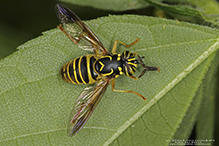 |
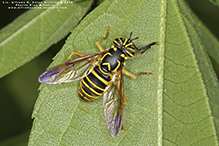 |
|
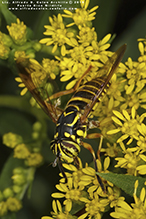 |
||
A lovely Bee Mimic Fly |
||
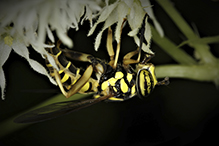 |
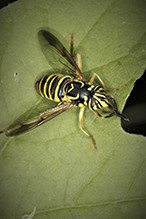 |
|
MinnesotaSeasons.com Photos
|

Slideshows

Visitor Videos
Share your video of this insect.
This button not working for you?
Simply email us at info@MinnesotaSeasons.com.
Attach a video, a YouTube link, or a cloud storage link.
Other Videos
Syrphid Fly (Spilomyia longicornis) on Eupatorium altissimum (Asteraceae) [125] Scene#023 Sep16 2012
Nature Documentaries
Wasp-like hoverfly (Spilomyia longicornis) drinking nectar in flowers
GoTrails
Behavioural mimicry in the hover fly Spilomyia longicornis (by Henri Goulet)
Chris Hassall

Visitor Sightings
Report a sighting of this insect.
This button not working for you?
Simply email us at info@MinnesotaSeasons.com.
Be sure to include a location.
Minnesota Seasons Sightings



